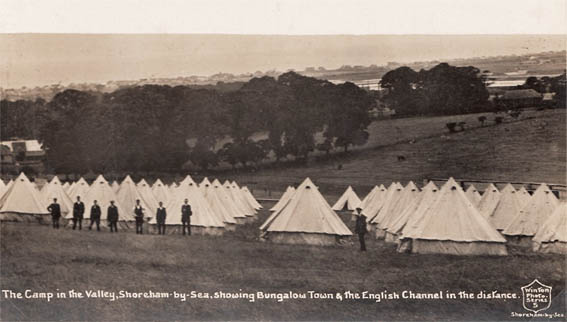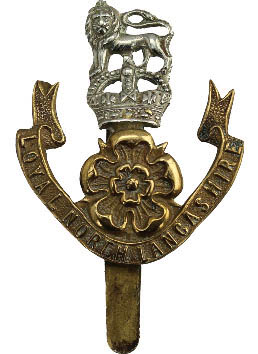Harold Ernest Potter was the sixth child of George and Amy Potter of Eastbourne in Hampshire; he was born there on 8th December 1885. In 1901, Harold was a grocer’s assistant. On the 5th November 1910, he started work as an attendant at St Audry’s, the Suffolk County Asylum. His younger brother, Cecil, also worked there but left in 1911. Cecil was a sportsman and was part of St Audry’s 1911 cup winning football team.
On 14th November 1914, Harold enlisted and joined the 9th (Service) Battalion Suffolk Regiment who were raised in Shoreham in September 1914. He was to be one of nine men from Melton who joined them.
Shoreham Camp where the 9th Suffolks were based under canvas in the winter of 1914.
The 9th Suffolks were under canvas at Shoreham Camp but owing to the poor weather, which turned the ground into a quagmire, they were sent to billets in Brighton. The following spring, they returned to Shoreham where training resumed. In April, the battalion moved inland to Reigate in Surrey, and in mid June, to Pirbright Camp in Aldershot to prepare for mobilisation.
Towards the end of August 1915, Harold and the 9th Suffolks received orders for France. On the 30th, they embarked from Southampton, arriving in Boulogne in the early hours of the following morning. They were then sent to Allette, where they underwent further training until 21st September, when they received orders to go to Bethune – seventy miles away. After a rain-drenched four-day march, they arrived at their destination on the 25th, expecting a forty-eight-hour rest period to recover which never happened. Further orders were received at 04:00 the following morning, sending them on to Vermelles and the imminent Battle of Loos. The battalion was to sustain one hundred and thirty-five casualties and the award of a Victoria Cross to Sergeant Arthur Saunders.
On the 1st July 1916, the 9th Suffolks were fighting in the Ypres Salient based at Sailly La Bourse. A month later. the battalion was ordered to the Somme, arriving in the Albert sector on 4th August, taking over trenches at Mailly-Maillet Wood, where they remained for the next three weeks. Their next task was particularly distressing: clearing the battlefield of the dead from Ulster Division. The 9th Suffolks remained in the Albert Sector area for the rest of the battle of the Somme, taking part in the attack on the Quadrilateral on 13th September, where another Melton man, Frederick Beaden, was awarded the Military Medal. After these actions, the battalion went into training with an occasional posting to the front line trenches.
Cap Badge of the Loyal North Lancashire Regiment
In the autumn of 1917, Harold was granted leave and returned to Suffolk to marry Violet Florence Golders, a nurse he had met while working at St Audry’s. After Harold’s return to the front line, he and the battalion were moved back to the Loos sector where they remained until February 1918, when the 9th Suffolks were disbanded. Harold was posted to join the 9th Loyal North Lancashire Regiment along with another Melton man, Morris Cale, together with around thirty- seven other men from the 9th Suffolks.
At the end of the war, Harold was posted to join 7 Company, 3rd Suffolks at their base in Felixstowe. From here, he re-applied for his job at St Audry’s, who were required to keep his position available once the hostilities had ceased. In his letter of application, he states that he will be staying in England and would like to be allocated a cottage. He resumed work in July 1919 and in the autumn of 1919 their daughter, Elsie, was born. Harold continued to work at St Audry’s, having qualified as a mental nurse, until 10th July 1925. It was at this point the family moved to Warsash in Hampshire. By 1931, the family had moved once more, this time to Wales. In 1939, Harold and his family were living in Llechryd, Cardiganshire, Wales, where Harold continued working as a mental nurse.
Harold and Violet moved back to Suffolk and lived in Rushmere; he died on 19th May 1957 at the age of seventy-one and Violet, in 1975. Both are buried in St Andrew’s Churchyard, Rushmere.
For his war service, Harold was awarded the 1914-15 Star and the British War and Victory Medals.
